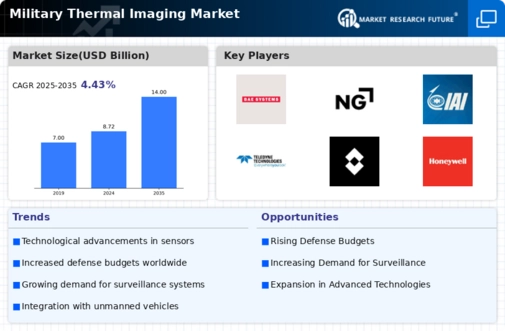Top Industry Leaders in the Military Thermal Imaging Market

The Military Thermal Imaging Market is a critical sector within the defense industry, playing a vital role in enhancing situational awareness, target acquisition, and surveillance capabilities for military forces. This comprehensive overview explores the competitive landscape, encompassing key players, strategies, factors for market share analysis, new and emerging companies, industry news, and current investment trends, shaping the overall competitive scenario.
Strategies Adopted By Key Players Military Thermal Imaging Market
- Lockheed Martin (US)
- Aselsan (Turkey)
- Thales Group (France)
- Raytheon Company (US)
- Northrop Grumman (US)
- L-3 Technologies (US)
- Ultra Electronics (UK)
- Israel Aerospace Industries (Israel)
- MOOG Inc. (US)
- Flir Systems (US)
- Rafael Advanced Defense Systems Ltd. (Israel)
- Qioptik (Paris)
Key players in the Military Thermal Imaging Market deploy strategic initiatives to maintain and strengthen their market positions. Continuous investment in research and development is a common strategy to introduce innovative thermal imaging technologies, including enhanced sensor resolutions, multi-spectral imaging capabilities, and integration with other sensor systems. Moreover, strategic collaborations with defense contractors, international partnerships, and military research institutions facilitate the development of tailored solutions, ensuring thermal imaging systems meet the evolving needs of modern military operations.
Factors for Market Share Analysis:
Market share analysis in the Military Thermal Imaging Market is influenced by critical factors such as the performance and sensitivity of thermal imaging sensors, the ability to operate in various environmental conditions, and compliance with stringent military standards. Companies excelling in delivering thermal imaging solutions with long-range detection, high-resolution imagery, and advanced image processing capabilities are likely to secure a significant market share. The capacity to address the diverse requirements of different military platforms, including ground-based, airborne, and maritime applications, is crucial in determining market dominance.
New and Emerging Companies:
In the evolving landscape of the Aerospace Military Thermal Imaging Market, new and emerging companies are making noteworthy strides. Entities such as Teledyne FLIR, Roketsan, and HGH Infrared Systems bring innovative approaches to thermal imaging technologies, focusing on advancements in compact designs, artificial intelligence integration, and modular sensor systems. These companies contribute agility and niche expertise, challenging traditional approaches and introducing disruptive technologies that address specific challenges in modern military reconnaissance and surveillance.
Industry News:
Recent industry news underscores the dynamic nature of the Aerospace Military Thermal Imaging Market, with reports of successful thermal imaging system deployments, partnerships between thermal imaging manufacturers and defense agencies, and advancements in technologies such as uncooled thermal sensors. Additionally, news regarding the integration of thermal imaging with unmanned aerial vehicles (UAVs), the development of long-range thermal imaging systems, and international collaborations for joint military exercises highlight the industry's commitment to staying at the forefront of evolving military requirements. Such developments contribute to the evolving landscape and indicate a shift towards more advanced and adaptable thermal imaging solutions.
Current Company Investment Trends:
Investments in the Military Thermal Imaging Market reflect a commitment to advancing technology and addressing the evolving needs of modern military operations. Key players are investing significantly in research and development to enhance the capabilities of thermal imaging systems, improve sensor technologies, and address emerging challenges such as countermeasures against thermal detection. Strategic acquisitions and partnerships to expand solution portfolios, ensure interoperability, and address evolving military threats are common investment trends. Furthermore, advancements in artificial intelligence for target recognition, the integration of thermal imaging with other sensor modalities, and the exploration of new materials for sensor development are notable focus areas, aiming to enhance the overall performance and versatility of thermal imaging solutions.
Overall Competitive Scenario:
The overall competitive scenario in the Military Thermal Imaging Market is characterized by a blend of established players providing comprehensive solutions and innovative newcomers introducing disruptive technologies. As military forces seek to enhance their reconnaissance and surveillance capabilities, the competition revolves around delivering thermal imaging systems that offer not only cutting-edge technology but also adaptability to different mission profiles and environmental conditions. The ongoing advancements in multi-spectral imaging, artificial intelligence integration, and the development of lightweight and portable thermal imaging solutions further shape the competitive dynamics in the market.
Recent Development:
January 2024:
Leonardo DRS (USA): Secured a USD 94 million contract from the US Army for advanced infrared weapon sights for infantry snipers. The Family of Weapon Sights - Sniper, Improved Night/Day Observation Device Block III, aims to provide extended-range target detection, environmental observation, and bullet trajectory tracking.
Thales Group (France): Successfully completed night vision integration testing on its Scorpion reconnaissance helicopter for the French Army.


